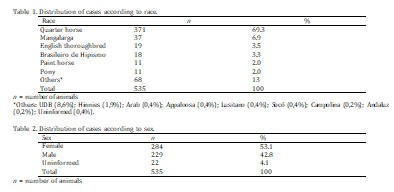Epidemiology of colic syndrome in horses over 15 years of care
DOI:
https://doi.org/10.21708/avb.2020.14.3.9176Abstract
Colic syndrome is a condition of great importance in equine production, a syndrome considered to be complex and multifactorial in nature. In this way epidemiological studies have been acting to contribute to the identification of risk factors in the development of wind power. This study evaluated the clinical epidemiology of the colic syndrome according to race, gender, diagnosis, affected segment, therapeutic decision and outcome of the cases treated at the Veterinary Hospital "Dr Halim Atique", interior of São Paulo. The medical records of the animals assisted from January 2004 to July 2018, whose complaint was abdominal discomfort, were evaluated. Of the 535 animals, the most affected breed was the Quarter Horses (69.3%) followed by the Mangalarga (6.9%); females (53.1%) were more prone to the development of the syndrome. Compaction (28.8%), gastritis (11.8%), followed by gas distension (10.3%) were the most frequent changes; the affected segments being the stomach (21.9%), major colon (17.2%), and small intestine (15.7%). Clinical treatment (64.7%) was the most instituted and in the outcome of the cases, the discharge (77.4%) prevailed. The study presents data that can support epidemiological research in the area, assisting in the identification of causal and predictive factors for the colic syndrome.
Downloads

Downloads
Published
Issue
Section
License
Autores que publicam na Acta Veterinaria Brasilica concordam com os seguintes termos: a) Autores mantém os direitos autorais e concedem à revista o direito de primeira publicação, com o trabalho simultaneamente licenciado sob a Licença Creative Commons Attribution que permite o compartilhamento do trabalho com reconhecimento da autoria e publicação inicial nesta revista. b) Autores têm autorização para assumir contratos adicionais separadamente, para distribuição não-exclusiva da versão do trabalho publicada nesta revista (ex.: publicar em repositório institucional ou como capítulo de livro), com reconhecimento de autoria e publicação inicial nesta revista. c) Autores têm permissão e são estimulados a publicar e distribuir seu trabalho online (ex.: em repositórios institucionais ou na sua página pessoal) a qualquer ponto antes ou durante o processo editorial, já que isso pode gerar alterações produtivas, bem como aumentar o impacto e a citação do trabalho publicado (Veja O Efeito do Acesso Livre).


 Esta obra está licenciada com uma Licença
Esta obra está licenciada com uma Licença 